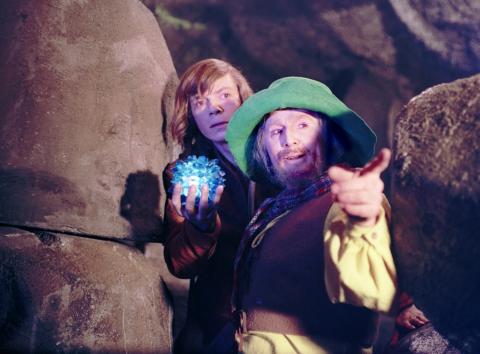East German Film Festival Celebrates 10th Anniversary with March 28-30 Screening
The 10th annual East German Film Festival at The University of Scranton will screen three films based on classic Grimm brothers’ fairy tales March 28, 29 and 30 in the Pearn Auditorium of Brennan Hall. The screenings, which begin at 7:30 p.m. each evening, are free of charge and open to the public. The festival, co-sponsored by the University’s Department of World Languages and Cultures, is presented in collaboration with the DEFA (Deutsche Film-Aktiengesellschaft) Film Library at the University of Massachusetts at Amherst. The library is the only archive and research center outside of Germany devoted to films from and related to the former German Democratic Republic (GDR).
“Live action fairy tale films were among the first and most lavishly produced feature films in the East, with budgets that well exceeded comparable films in the West,” said Jamie Trnka, Ph.D., associate professor of world languages at the University. “This demonstrates the studio’s commitment to reinterpreting classic works of German folk culture for education and entertainment.”
Dr. Trnka will introduce the films and lead a discussion following each screening.
The following films will be screened at this year’s festival:
Tuesday, March 28: “The Blue Light” (1976. 79 minutes. German with English subtitles.) Directed Iris Gusner and based on a fairy tale by the Grimm brothers, the film follows, Hans, faithful soldier of his king who is cheated out of his pay and injured. A witch heals his wounds and demands in return that he fetches a blue light from the dried-up well. Hans outsmarts the witch, keeps the glowing stone and gains the services of a little magician, who finally helps him to trick the contemptuous king. (7:30 p.m., Pearn Auditorium, Brennan Hall. Free.)
Wednesday, March 29: “Three Hazelnuts for Cinderella” (1974. 74 minutes. Dubbed in English.) Directed by Václav Vorliček, the film follows the fairy tale of Cinderella. After her father's death, Cinderella's stepmother forces her to work as a maid at the family’s manor. When Cinderella meets a prince in the woods, she falls in love with him but is too embarrassed by her ragged clothes to act on her feelings. The family’s coachman gives Cinderella three magic hazelnuts containing three different garments: men’s hunting garb; a ball gown; and a wedding dress. Cinderella uses these disguises to cleverly and bravely to capture the prince’s heart. After a long search, the prince finally recognizes the young woman he met in the woods. (7:30 p.m., Pearn Auditorium, Brennan Hall. Free.)
Thursday, March 30: “Rumpelstiltskin” (1959. 69 minutes. German with English Subtitles.) Directed by Christoph Engel, the film, based on the Grimm brother’s fairy tale, is laced with socially critical overtones in its analysis of work and exploitation. A boastful miller pretends that his daughter Marie can spin straw into gold, and so the king locks her into a room full of straw and orders her to spin it into gold. A little man appears and offers his help in exchange for her first-born child. The delighted king then marries Marie, but when their child is a year old, the little man returns to claim his payment. Because he likes the kind-hearted Marie, he allows her to save her child if she can guess his name in three days. In the DEFA version, Marie enlists the help of her husband and the entire kingdom to discover the little man’s name. (7:30 p.m., Pearn Auditorium, Brennan Hall. Free.)
For more information about the film screenings, please contact Dr. Trnka, at 570-941-7430 or Jamie.trnka@scranton.edu.

About East German Live Action Fairy Tale Films:
“In striking and self-conscious distinction from Disney films, DEFA’s fairy tales shift attention from magical solutions to human agency. They tend to embed tales in contemporary social problems where Disney films encourage slap-stick humor and distraction rather than reflective viewing.”
“In the 19th century, the Brothers Grimm undertook the task of collecting and publishing German tales that supported claims to German cultural distinction on the eve of national unification. Decades later, the East German film studios again turned to fairy tales as an important German cultural and literary inheritance to bolster claims for political recognition.”
“Live action fairy tale films were among the first and most lavishly produced feature films in the East, with budgets that well exceeded comparable films in the West. This demonstrates the studio’s commitment to reinterpreting classic works of German folk culture for education and entertainment.”
“These films were among the most popular and profitable ever produced by DEFA, and had large, international audiences in both the Soviet Bloc and in the West.”
Jamie Trnka, Ph.D., associate professor of world languages at The University of Scranton
“The Blue Light” is among the films to be shown at The University of Scranton’s 10th annual East German Film Festival, which will be held at 7:30 p.m. March 28, 29 and 30 in the Pearn Auditorium of Brennan Hall. The screenings are free and open to the public.






